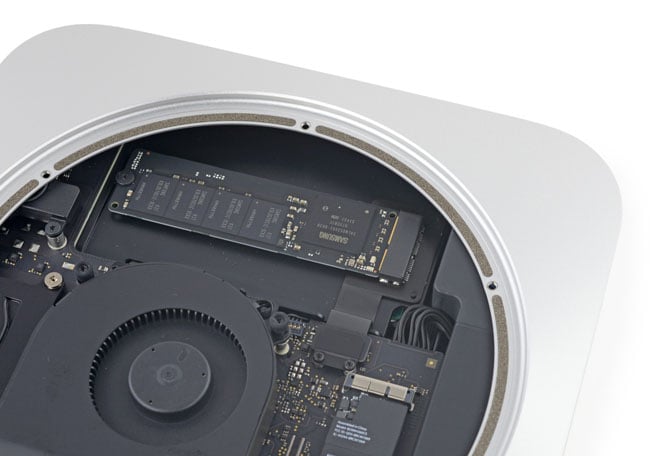The apple Mac mini
The Mac Mini is a machine I half expected Apple to quietly drop. The decline of the desktop personal computer business in general, and the fact that you’ll never see a Mac Mini as a prominent piece of product placement, means this miniature micro is unlikely to ever to hold a place in Apple's heart like the iMac.
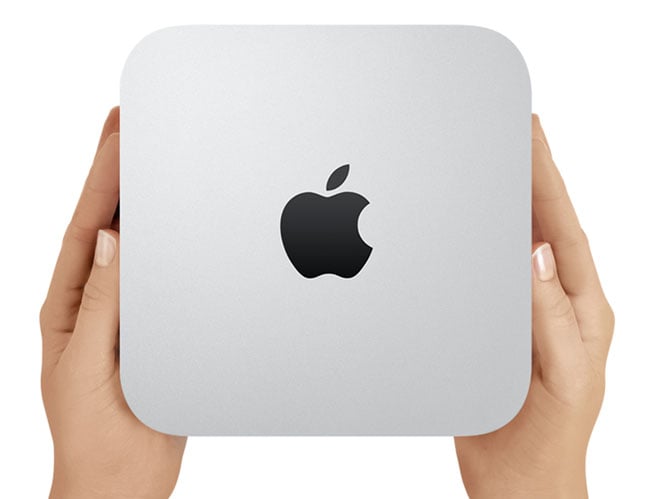
A safe pair of hands? Apple's Mac Mini late 2014 edition
Indeed, it’s been a full two years since Apple last revised the Mini, leaving many of its fans fearful that it might be on its way out, victim of changing tastes in computing products.
But no, just when you’ve given up waiting for the bus and ready to plod your weary way home, along come three — units Apple would once have labelled Good, Better and Best. The year-long wait for Intel’s impressive Haswell processor to come to the Mini is over, and that’s very welcome. Ditto the addition of 802.11ac Wi-Fi. The quid pro quo is the loss of upgradeable RAM.
Let’s be clear: the Mini was never an easy upgrade. Getting the hard drive out involves removing all of the machine’s internals. It still does. But at least it used to be a doddle to expand the previous incarnation’s memory: rotate the base, unclip the Wi-Fi card’s antenna, unscrew a metal plate, and there’s your RAM slot.
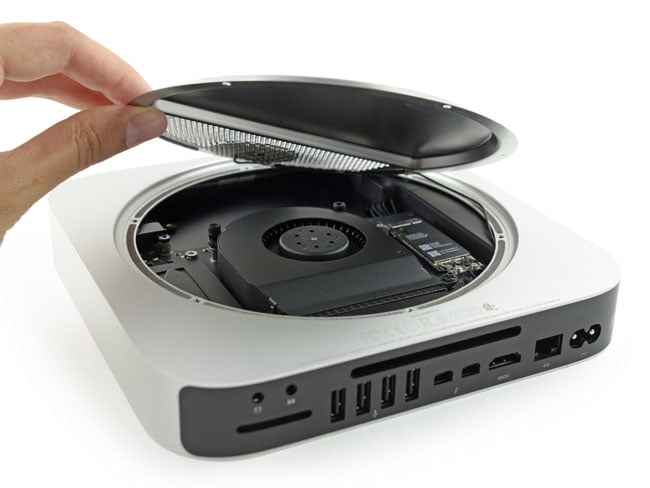
Easy upgrade? Depends what you want to change
Source: iFixit.com
Source: iFixit.com
No longer. The base is clipped in place, and beneath the metal plate ... soldered memory. Apple’s build-to-order memory is less expensive than it used to be — £80 for a 4GB upgrade from the base 4GB isn’t as daunting as £80 was two years ago – but it’s still a darn sight less cost-effective than buying memory from someone like Crucial and fitting it yourself. Doubly so if you want 16GB.
Moreover, being able to upgrade your system as you need — rather than investing all at the start – is half the point of buying a desktop rather than a laptop. The other half is better performance, though with the Mini that’s perhaps less of a concern thanks to its laptop-derived parts and ultra-compact form-factor. This is not a computer for customisation.
Of course, that’s probably why Apple felt it could get away with its margin-enhancing plan to solder down the RAM; it’s why it stopped bundling an HDMI-DVI adaptor too. No one will upgrade the Mini, it thought; you can’t replace the CPU, and the graphics core is integrated so that can’t be swapped out either.
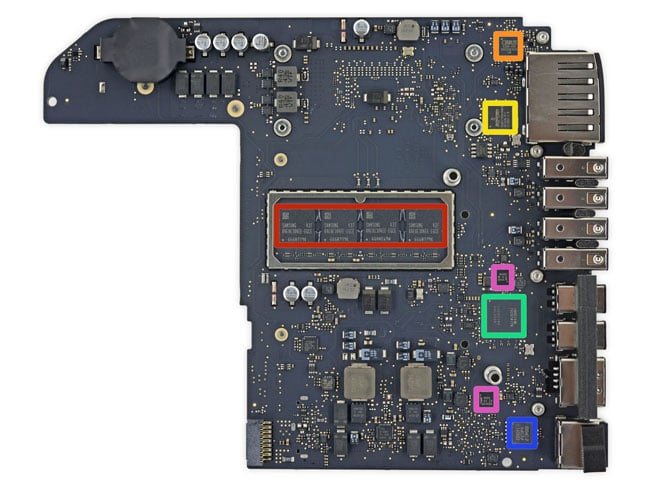
The soldered on-board RAM highlighted in red isn't exactly enticing on desktop machine
Source: iFixit.com
Source: iFixit.com
OK, so that’s not an unreasonable assumption but it’s nonetheless very disappointing for those of us who like Macs for more than their consumer convenience. You can add RAM to the iMac, for instance, so why penalise Mini buyers, especially when you already have an elegantly engineered mechanism for memory upgrades?
Soldering on
Mac OS X isn’t quite the RAM gobbler that Windows is, but since the Mini uses integrated graphics, that’s a big chunk of RAM nabbed before you’ve even started running applications, especially if you’re using multiple displays or even a single screen with a greater-than-HD resolution.
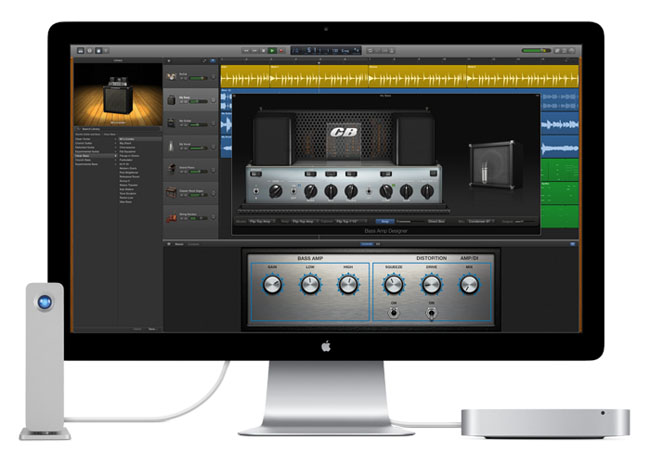
Just how much RAM do you need to run a bunch of music plug-ins smoothly?
The Mini I have here has 8GB of RAM and I would‘t take anything less. Mac OS X Yosemite, pre-installed on the new Mini, demands rather more memory than its predecessors did — more daemons, more backgrounded apps, more memory leaks. Even with only a handful of basic applications open, this Mini is already consuming just under 7GB of the installed eight.
Trouble is, I can't do anything about that. I can’t assess my memory usage on a new platform and then expand the memory as necessary. Who cares if no other Mini user wants to do this. I do. For the sake of perhaps five dollars for the memory slot and the tooling for the removable base, Apple has made its little machines far less attractive for anyone not seeking an appliance. And surely those people are among the iMac’s natural constituency, not the Mini’s?
If you do open up a 2014 Mac Mini, it’s still an engineering marvel. All kitted out in silver and black, it’s as attractive on the inside as it is on the outside, as the iFixit disassembly pics on here reveal. Better than anything I can take, these shots will show you exactly how accessible the new Mini isn’t. Getting to the 5400rpm 500GB hard drive (in the base model; others have bigger drives and even a Fusion Drive SSD cache) is a chore, but doable.
In use, this box, based on a 1.4GHz dual-core Core i5-based 4260U CPU feels fluid, and unlikely to trouble any but the most power-hungry users. As I say, it’s the lack of memory expansion that’s the problem here.

Alas, no FireWire but you do get two Thunderbolt 2 ports now
There’s a problem for users with Firewire peripherals too: Apple has dropped the Firewire 800 port it had placed on the back of the 2012 model. In its place is a second Thunderbolt port which will come in handy if you’re driving your monitor off the other one. The new Mini, like the old, has HDMI, but that limits you to 1920 x 1080. Thunderbolt drives my 2560 x 1440 Dell display very well.
The Mini still has a useful four USB 3.0 ports and the SD card slot. Once again, the PSU is built in; no brick hanging off the back here. Gigabit Ethernet rounds off the new Mini’s port array; the internal Wi-Fi has been upgraded from 802.11scores
The CPU may have altered, but the performance hasn’t. Geekbench 3 yields 64-bit single-core and dual-core ratings of 2800 and 5382, respectively. The 2012 Mini El Reg reviewed had a 2.5GHz Core i5-3210M, based on Intel’s third-gen Core architecture.
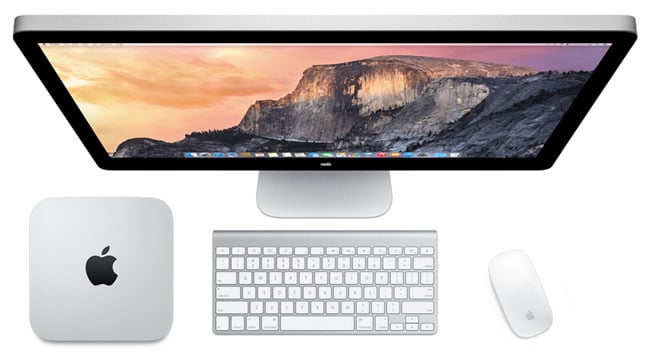
Out-of-the-box the only accessory provided now is a power cable
Its clock speed was almost twice that of the Haswell CPU in the new model and with a slightly higher (3.0GHz to 2.7GHz) Turbo Boost speed. The previous Mini was tested with Geekbench 2 which generated results not directly comparable with those of Geekbench 3, but numbers from the database of the benchmark’s developer, Primate Labs, put the old model on averages of 2630 (single core) and 5418 (multi-core).
So the new model, with a lower average clock speed, is delivering very slightly better performance. But it’s not a stellar increase, and certainly no reason to sell off your 2012 Mini for a new one. Indeed, given the upgradeability of 2012’s model, you might even prefer to seek one out second-hand and spend the difference getting yourself an SSD and a big memory boost.
The former, in particular, will be a noticeable improvement as you reduce the ‘lag’ of the 5400rpm HDD thanks to faster start-up times and application loads.

Lower price, but fewer user upgrade options
The one piece of good news here is that Apple has knocked £100 off the price tag. The base 2012 model would have set you back £499; today’s entry level Mini is £399. Price reductions are nice, but in this instance it’s small compensation for the loss of a memory slot: most of that £100 will go on a measly 4GB build-to-order upgrade.
Spending £170 more than the base price gets you the 2.5GHz Core i5 version, 8GB of memory and a 1TB HDD if you need the space. A further £230 (total: £799) buys you a 2.8GHz Core i5, 8GB of RAM, 1TB of HDD plus a 256GB SSD. Both the latter versions include Intel’s Iris Graphics; the baseline model has Intel HD Graphics 5000.
The cores are the same; the Iris just has a higher clock speed than the 5000. It’s more a nice-to-have than a must-have, especially if you’re not gaming. Two years on, my ageing copy of Doom 3 steps from 44fps to 54fps at 1920 x 1080.
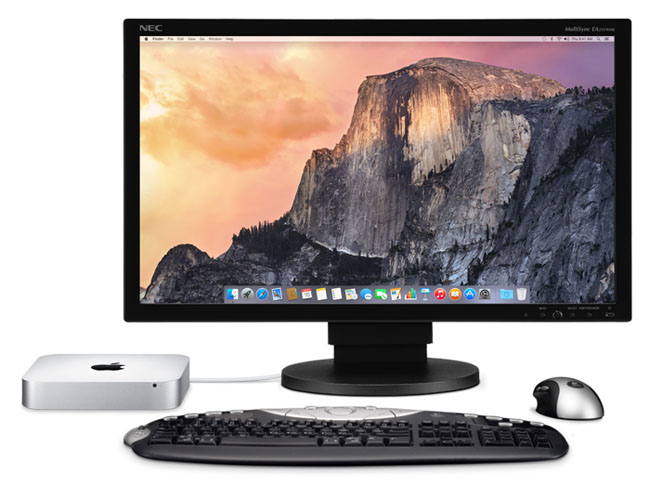
Use your old peripherals and spend the savings on RAM
The Reg Verdict
The Mac Mini remains a stylish, very compact desktop with the ability to drive greater-than-HD displays. It’s no games machine, but it does make for a very nice general productivity box. Thanks to OS X’s foundations, it’s a great Unix machine too thanks to wide access to both open source and commercial software.
I’m going to get one to keep in the office, to save me carrying a laptop back and forth. I just think I might see if I can find a discounted 2012 model, its initially wobbly HDMI output now long fixed, rather than the current one and grab some extra memory for it.
